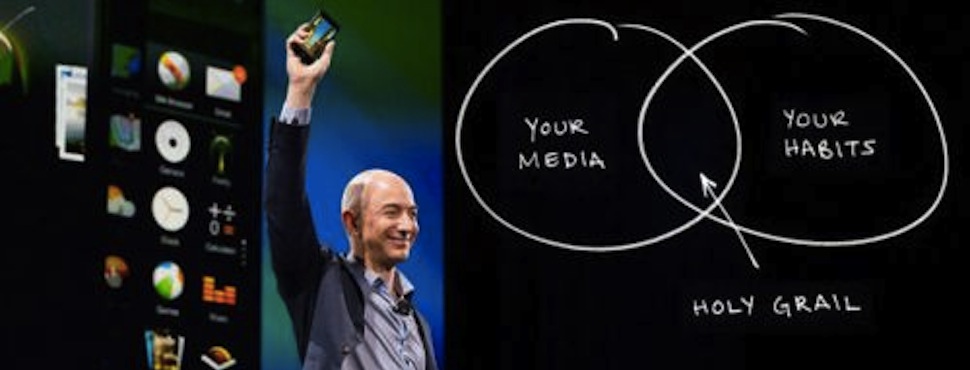“It’s our job to keep inventing and to be patient. One thing leads to the next.”– Jeff Bezos
It’s a mark of how technology journalism has evolved that the unveiling of Amazon’s Fire Phone wasn’t just greeted by coverage of its technical specifications. Yes, it has a 4.7-inch screen, 13-megapixel camera, and a quad-core processor, but most reports recognized that these were just details – and increasingly par-for-the-course ones in the smartphone market.
Even the four front-facing cameras that track the Fire Phone owner’s head gestures to help show images in “dynamic perspective” were – while respected for their innovation – seen as something of a novelty feature for now.
It was striking (and welcome) that plenty of coverage of Jeff Bezos’ new gadget sought to dig deeper and understand what the Fire Phone means for Amazon, and its vision of the future of media.
Or, to phrase it more rudely: what’s really going on here, beyond a not-that-cheap smartphone with a few extra bells and whistles, available in a single country with a single operator?
First, the Fire Phone fits into a wider narrative about Amazon’s evolution into a media company, with its own ecosystem of devices, software and services. Like Apple, it has devices – a smartphone, tablets and a set-top box, the Fire TV – as well as its own app store and digital media services.
The difference is that Amazon’s services are wrapped into a bigger subscription offering, Prime, which costs $99 a year in the US.
Fire Phone buyers will get their first year free, and beyond its free two-day shipping of products bought from Amazon, Prime will also offer them access to its streaming films, TV shows and (a recent addition) music, as well as a 500,000-strong “lending library” of Kindle e-books.
Amazon has beaten Apple and Google (not to mention Sony and Microsoft) to the idea of an umbrella subscription service spanning multiple kinds of entertainment, but it’s been a stealthy progression.
Fire Phone is one more entry point to Amazon’s media ecosystem, where there’s a lot of interesting thinking going on. The recently-launched Prime Music, for example, swerves the 20m-song catalogues of services like Spotify in favor of a tighter selection of music, navigated mainly through playlists based on familiar artists and genres. It’s definably different to rivals.
Amazon Studios, meanwhile, has been taking a fascinatingly-crowdsourced approach to commissioning original TV shows, pushing pilots out to Prime users then using their reviews and ratings to decide whether to buy full series.
They might not be watched on Fire Phone that much – Fire TV, more so – but the new smartphone will nevertheless help swell the potential audience for these shows, thanks to that free year’s Prime membership that comes with it.
One of the most interesting features of the Fire Phone is Firefly, though: its software for identifying things in the real world – from music and TV shows to physical products – through a mixture of audio recognition and image recognition / barcode scanning.
There’s a lot of interest in the implications Firefly has for shopping: the prospect of Fire Phone owners merrily scanning products in shops to order them online more cheaply.
It’s true: that is a very disruptive thought – albeit one that applies just as much to Amazon’s apps on iOS and Android, which can already scan barcodes, and could have the audio aspect added to them too, in a future update.
Firefly is also interesting for its potential to help Amazon understand our media usage, in the same way that a feature on Fire TV called ASAP – which monitors what you watch then pre-buffers TV shows and films it thinks you’ll like – does.
Historically, Amazon has understood a lot about its customers’ buying habits, but rather less about their usage: it knows you bought a certain CD or book, but not how much you played the former and whether you finished and/or liked the latter (although in the case of Kindle e-books, it does know how far you got through).
Firefly can be seen as part of Amazon’s attempts to understand usage as well as purchasing behavior – and that is surely a big part of the Fire Phone’s overall strategy, given that smartphones are now our most personal, most-used devices in our daily lives.
Finally, Fire Phone’s launch reinforces a wider trend that’s been happening for some time: the rise of technology companies as media and cultural gatekeepers, through their combinations of devices, software and services.
Amazon, Google and Apple in particular are now hugely powerful players in the media industry, for better or worse. When Amazon and Google’s YouTube use this muscle in negotiations (with, respectively, book publisher Hachette and independent music labels) it makes headlines. They won’t be the last.
But it’s also true that for these companies and other technology firms – from Microsoft and Sony to Netflix and Spotify, taking in Facebook and Twitter along the way – there’s a drive to understand us better through our media habits, and use that understanding to make us ever more loyal customers.
Amazon’s Fire Phone will help it understand some of its customers a little (or perhaps a lot) better, and this is just the first-generation model. It’s a very smart move.
Stuart Dredge is a freelance journalist in the U.K. His writing appears in The Guardian, The Observer, Music Ally and his own apps-for-kids site Apps Playground. Follow him on Twitter @stuartdredge.
*First posted on Say Daily.

